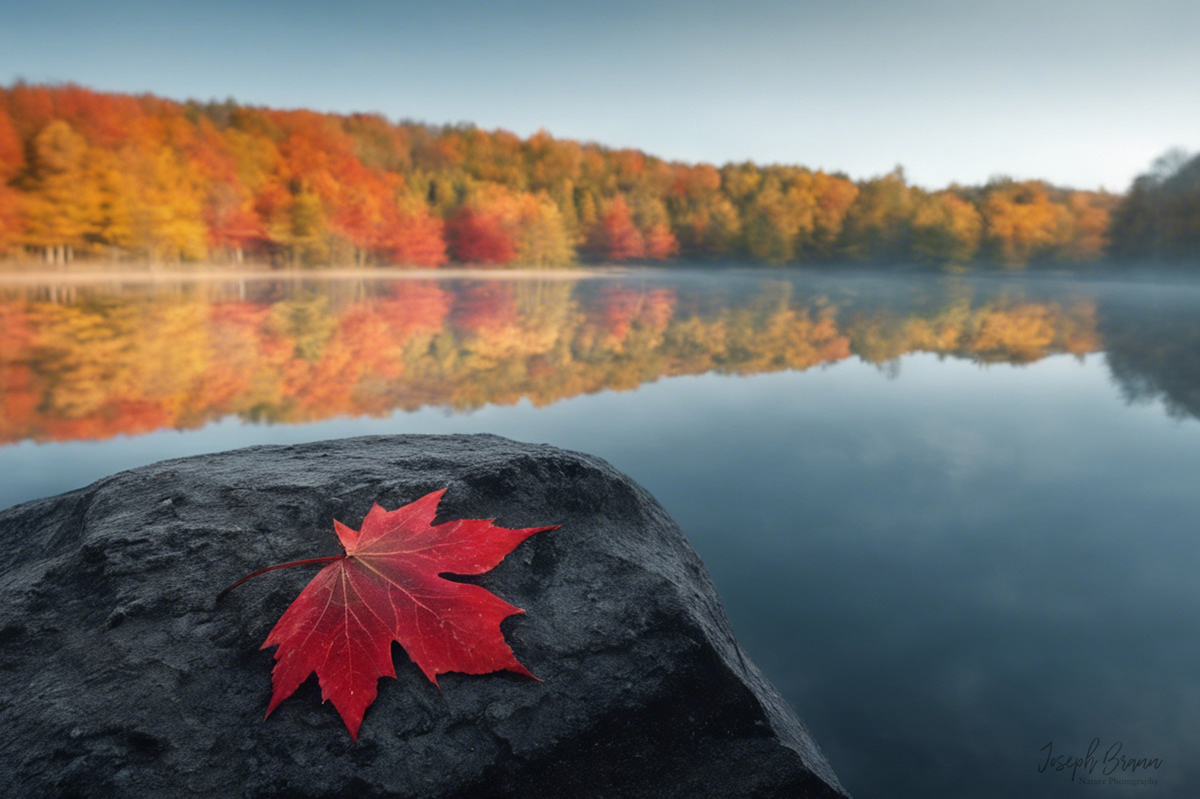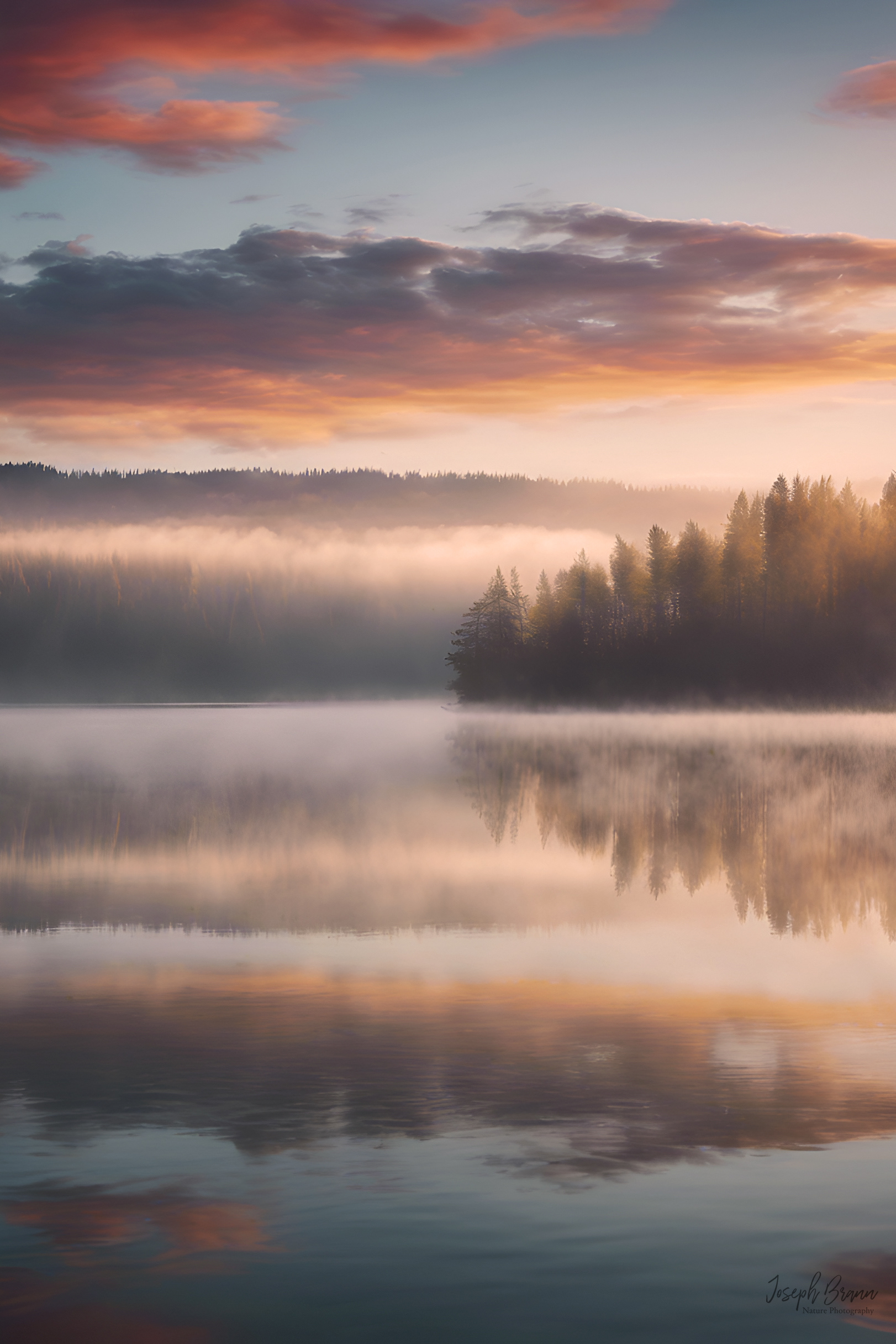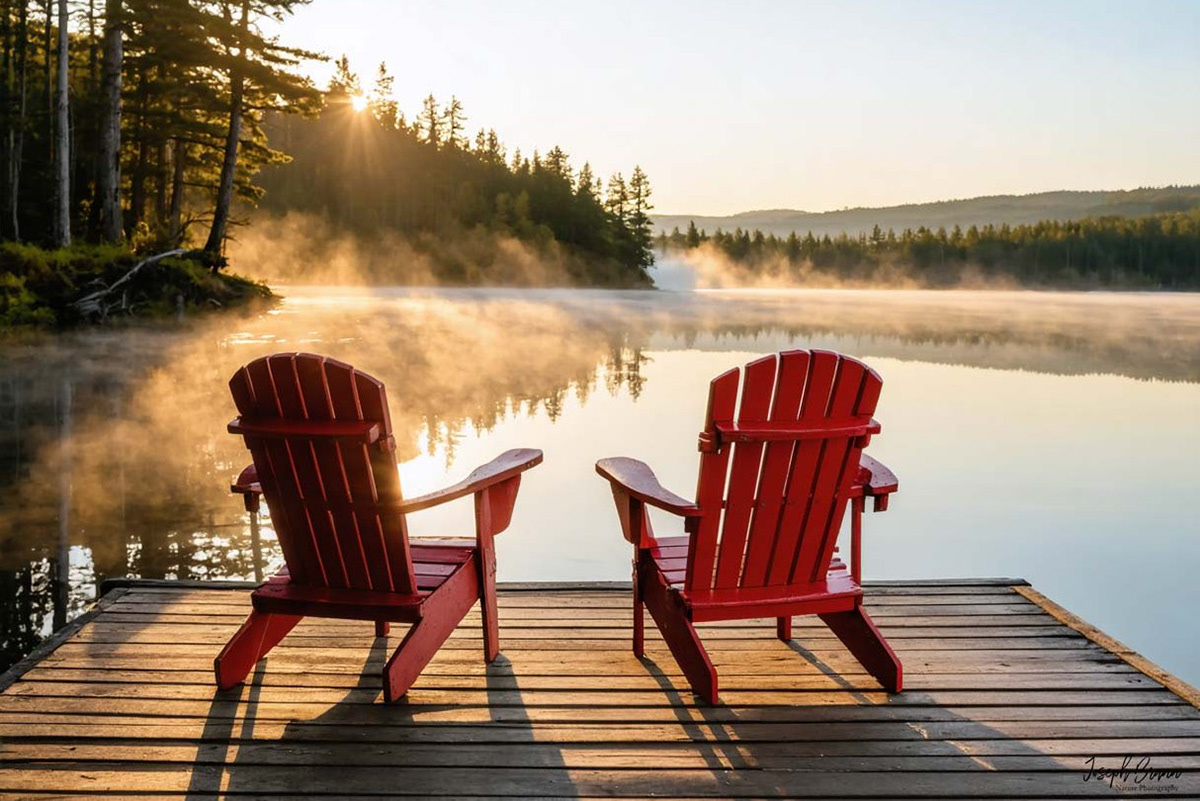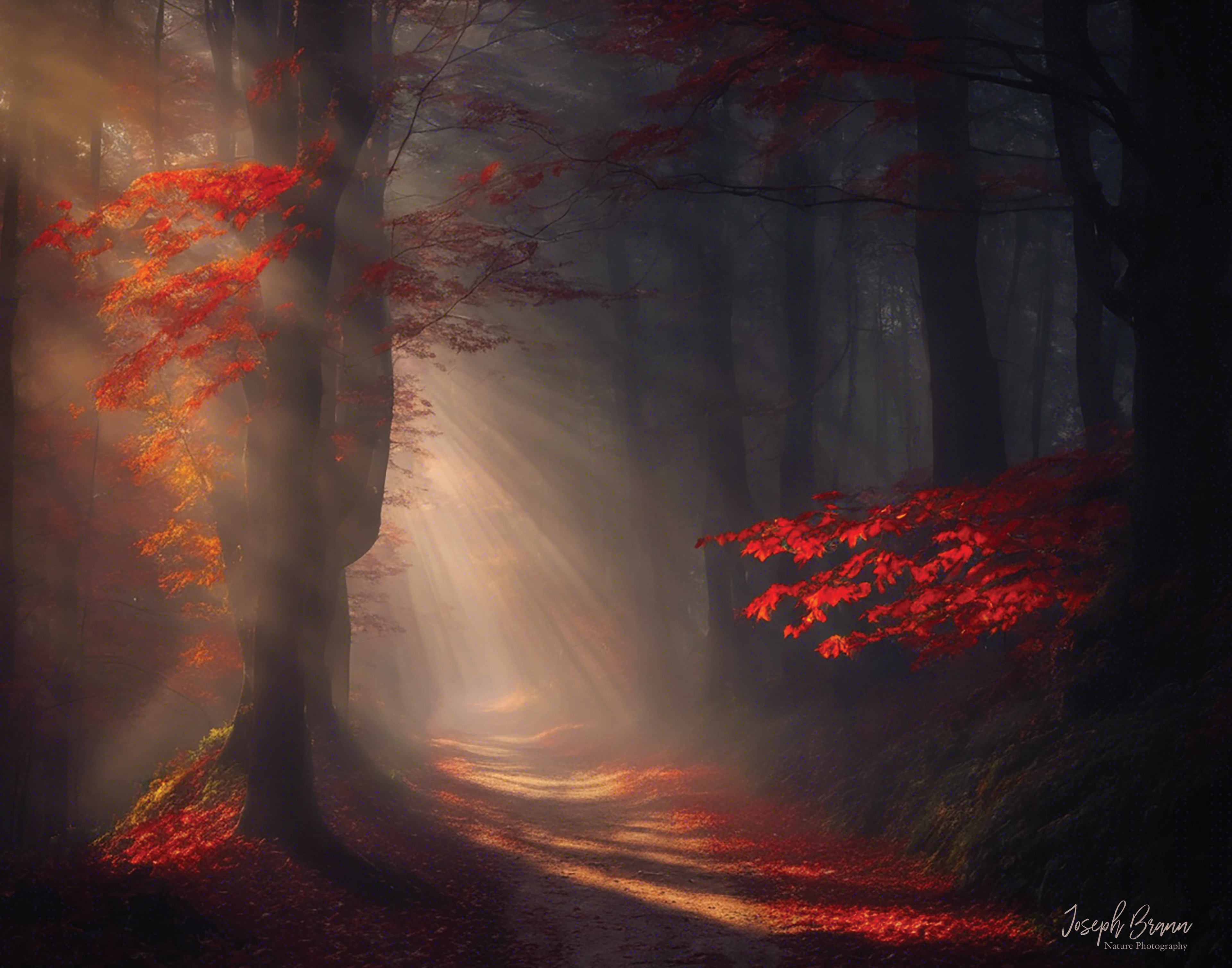Fresh Snow on the Bridge
There’s something peaceful about the way fresh snowfall softens the world. I came across a small bridge covered in a perfect layer of untouched snow — no footprints, no marks, just a smooth white blanket resting quietly over the wood.
The gentle curves of the bridge stood out against the stillness of the landscape, turning a simple spot into a winter scene that felt almost storybook-like. It’s amazing how the first snowfall can transform even the most familiar places into something new and magical.
Sometimes, all it takes is a quiet bridge and a dusting of snow to remind you why winter has its own kind of beauty.
November 17, 2025
When the Rain Whispers and the Leaves Are Nearly Gone
There’s a quiet kind of beauty that comes after the leaves have mostly fallen. The brilliant reds and golds of autumn fade into muted tones of brown and yellow and the landscape begins to exhale — soft, damp and reflective. Rain falls steadily now, washing away the last traces of colour and the world feels calm, almost thoughtful.
For photographers, rainy days can seem uninspiring at first glance. The skies are heavy, the light subdued, and the air carries that unmistakable chill of late October. But if you take a moment to look closer, there’s still magic waiting. Wet leaves cling to the forest floor, their colors deepened by the rain. Raindrops gather on bare branches, turning them into delicate strings of glass. Reflections shimmer in puddles, and the mist along the lakes and rivers blurs the line between earth and sky.
This is a time of transition — when nature pauses between seasons. It’s quieter, yes, but in that quiet comes mood, emotion and depth. Photographs taken now carry a different kind of story — one of change, of rest and of the beauty found in endings.
So don’t put the camera away just yet. Step outside with that raincoat, a steady hand and a sense of patience. Let the rain guide you to the small details: the way droplets trace paths down a weathered fence post or how a single maple leaf rests against a dark, wet rock. Sometimes, the softest moments hold the strongest emotion.
Soon the first snow will come, covering everything in a clean white hush. But for now, the world belongs to the rain — and to those who still see beauty in its quiet grey light.
October 18, 2025
Capturing Autumn: A Beginner’s Guide to Fall Photography - Oct 1, 2025
Autumn is one of the most beautiful times of the year for photography. The world changes its colours as the leaves turn shades of red, orange, and gold. The air feels crisp, the sun shines softer and everything seems to glow with warmth. For photographers—especially beginners—this is the perfect season to practice capturing nature’s beauty. Whether you’re using a professional camera or just your phone, autumn offers endless opportunities to take stunning photos.
In this post, we’ll go through beginner-friendly tips and ideas to help you make the most of fall. We’ll keep things simple, clear, and easy to follow so you can get outside and enjoy creating your own autumn photo collection.
Why Autumn is Perfect for Photography
Autumn is special because of its unique light, colours, and atmosphere. During summer, the sunlight is strong and harsh, which can create shadows that are hard to work with. In autumn, the sun sits lower in the sky, producing a golden, softer light. This makes everything look warmer and more inviting in photos.
The colours of the season are also incredible. Trees change from green to shades of orange, red, and yellow. Fallen leaves create natural carpets on the ground and misty mornings add mood and mystery. Even rainy days can be beautiful when you capture wet leaves or reflections in puddles.
In short, autumn provides variety—and variety is exciting for photographers.
Equipment: What You Need (and Don’t Need)
One of the best parts about photography is that you don’t need expensive gear to start. Beginners often think they must have the latest camera, but the truth is that great photos can be taken with whatever you have.
Smartphone Cameras: Most phones today have excellent cameras with features like portrait mode, HDR, and even built-in editing tools. They’re light, easy to carry, and great for capturing spontaneous shots.
DSLR or Mirrorless Cameras: If you own one, fantastic! These give you more control over settings like aperture, shutter speed, and ISO. But don’t feel pressured—your phone can do plenty.
Tripod: A simple tripod is useful for keeping your shots steady, especially if you’re shooting in low light or experimenting with long exposures (like capturing moving water in a stream).
Lenses (optional): If you have a camera with interchangeable lenses, a wide-angle lens is great for landscapes, and a 50mm lens is perfect for portraits among colorful leaves. But again—don’t stress if you don’t have these yet.
The most important thing isn’t the equipment. It’s your creativity, patience, and practice.
Understanding Light in Autumn
Photography is all about light, and autumn has some of the best light of the year.
Golden Hour: This happens shortly after sunrise and just before sunset. The light is softer and golden, making colors pop. It’s the perfect time for fall landscapes and portraits.
Overcast Days: Don’t skip cloudy days! Clouds act like a giant softbox, spreading the light evenly and reducing harsh shadows. This makes for great close-ups of leaves, mushrooms, or pumpkins.
Misty Mornings: If you wake up early, you may find fog or mist. These add atmosphere and mood, creating dreamy autumn photos.
Backlighting: Try standing so the sun is behind your subject. This can make leaves glow like stained glass. Be careful not to point directly into the sun unless you want a dramatic effect like a lens flare.
Learning to see light—and how it changes throughout the day—will make your photos stronger.
Tips for Capturing Autumn Colours
The main attraction in fall is the explosion of colour. Here are a few simple tricks to make those colours really shine:
Get Close to Leaves: Don’t just photograph whole trees. Zoom in on individual leaves, or capture a group of them on the ground. The details—like veins, textures, and water droplets—can be stunning.
Use Contrast: Colours look brighter when they contrast with something else. For example, a bright orange leaf against a dark log or blue sky will pop more than if it’s surrounded by similar colors.
Reflections: Look for lakes, ponds, or puddles where autumn trees reflect. These create mirror-like images that double the color.
Angles Matter: Instead of always shooting from eye level, crouch down, lie on the ground, or shoot upward toward the treetops. New angles bring fresh perspectives.
Avoid Over-Editing: While editing apps can boost colors, too much saturation makes photos look fake. Try to capture the natural beauty of autumn instead.
Composing Your Shots
Composition is how you arrange things in your photo. Even beginners can improve their photos a lot just by paying attention to composition.
Rule of Thirds: Imagine your photo is divided into a grid of 9 equal parts. Place important elements along these lines or where they intersect, instead of always in the center.
Leading Lines: Roads, fences, rivers, and trails can guide the viewer’s eyes into your photo. In autumn, a path covered in leaves can make a perfect leading line.
Framing: Use natural elements to frame your subject. For example, shoot a person through hanging branches, or frame a barn with colorful trees on either side.
Keep it Simple: Sometimes less is more. Don’t try to cram everything into one shot. Focus on one subject—a single leaf, a pumpkin, or a winding path.
Autumn Photography Subjects and Ideas
If you’re unsure what to photograph, here are plenty of ideas to get you started:
Landscapes: Wide views of forests, hills, or lakes surrounded by autumn colors.
Leaves: On the ground, floating in water, stuck to a window after rain, or falling from trees.
Close-Ups (Macro): Mushrooms, pinecones, acorns, berries, or frost on leaves.
Animals: Birds migrating, squirrels gathering food, or pets playing in fallen leaves.
People: Friends or family walking in the woods, kids jumping in leaf piles, or cozy portraits with scarves and hats.
Seasonal Scenes: Pumpkins, cornfields, scarecrows, apple orchards, or harvest decorations.
Weather: Mist, fog, frost, rain puddles, or even the first snow mixed with autumn leaves.
Autumn isn’t just about landscapes—it’s about capturing the feeling of the season.
Working with People in Autumn Photos
If you enjoy photographing people, autumn is one of the best times for portraits. The warm colors and soft light make everyone look good.
Clothing: Suggest earthy tones like beige, green, or brown, which blend with the season. Or go bold with red or mustard yellow to stand out against the background.
Props: A hot drink, a blanket, or a pumpkin can add story and coziness to a portrait.
Interaction: Instead of stiff poses, capture natural actions like walking through leaves, laughing, or tossing leaves into the air.
The goal is to show emotion and atmosphere—not just a person standing in front of trees.
Editing Your Autumn Photos
Editing is the final touch that can turn a good photo into a great one. Luckily, you don’t need complicated software—your phone or free apps like Snapseed, Lightroom Mobile, or VSCO work perfectly.
Adjust Brightness: Lighten darker areas if needed.
Boost Contrast: This makes colors stand out more.
Warm Up the Tones: Slightly increase warmth (yellow/orange) to enhance the autumn feel.
Sharpen Details: Bring out the texture in leaves or tree bark.
Crop Carefully: Remove distractions and focus on what matters.
Remember: small changes go a long way. Keep editing natural so your photos still feel real.
Practical Tips for Autumn Shoots
Here are a few extra tips to make your autumn photography smoother:
Dress Warmly: The weather can change quickly. Bring a jacket, gloves, and maybe even a thermos of tea.
Protect Your Gear: If it’s damp or rainy, keep your camera or phone dry. A simple plastic bag can help.
Go Out Often: Colors change fast in autumn. Visit the same spot a few times—you’ll notice how different it looks from week to week.
Be Patient: Sometimes the best light or scene takes time. Wait for the right moment, like a gust of wind blowing leaves.
Experiment: Try different settings, angles, and subjects. Photography is about learning by doing.
Finding Inspiration
If you ever feel stuck, look around for inspiration:
Walk through a forest or park and notice how light shines through leaves.
Visit a pumpkin patch, apple orchard, or farmer’s market.
Explore your own backyard or neighborhood—you don’t need to travel far to find beauty.
Look at other photographers’ autumn photos online for ideas, but don’t copy. Let them inspire you to try your own version.
The more you observe, the more you’ll notice little details worth capturing.
Final Thoughts
Autumn is a season of change, beauty, and emotion. For beginner photographers, it’s the perfect time to practice because nature provides so much variety—colorful leaves, dramatic light, and cozy scenes. Remember, you don’t need fancy equipment to capture stunning autumn photos. What matters most is your eye, your creativity, and your willingness to get out and explore.
Start simple: take a walk, notice the colors, and snap a few pictures. Try different angles, play with light, and experiment with editing. Over time, you’ll not only improve your photography skills but also create memories of autumn that you can look back on for years.
So grab your camera—or your phone—step outside, and let autumn’s beauty inspire you. Happy shooting!




Starting Your Journey into Nature Photography
June 9, 2025
Nature photography is a wonderful way to slow down and connect with the world around you. Whether it’s a quiet forest trail, a bird perched on a branch, or the glow of morning light over a lake, these moments are everywhere—you just need to look. You don’t need expensive gear to get started; even a phone camera can help you begin seeing the details that often go unnoticed. The key is patience and curiosity. Take your time, observe, and let the natural world reveal itself.
As you explore, pay attention to lighting, composition, and how different times of day change a scene. Try experimenting with angles—get low to the ground or shoot through leaves for a more creative feel. Most of all, don’t worry about perfection. The more you practice, the more your eye will develop. Nature photography isn’t just about taking beautiful pictures—it’s about deepening your appreciation for the world just outside your door.
Capture the Colours
April 10, 2024
Spring brings a burst of colour that invigorates both the senses and the imagination for photographers. From the delicate pastels of cherry blossoms to the bold tones of tulips and daffodils, nature offers a kaleidoscope of hues begging to be captured through the lens.
To truly bring these colours to life in photographs, it's not just about having technical proficiency, but also about cultivating an artistic eye and a creative spirit. Experimenting with composition and perspective can make the colours of Spring truly pop, whether by framing subjects against contrasting backgrounds or using leading lines to draw the viewer's eye.
Attention to light quality is crucial for enhancing spring colours. Soft, diffused light saturates colours, while harsh sunlight can wash them out. Shooting during golden hours or on overcast days can cast a flattering glow, bringing out the vibrancy of the season.
Ultimately, spring photography is about capturing the spirit of renewal and rebirth. With creativity and vision, photographers can showcase the beauty of spring in unique ways, creating images that delight and enchant viewers for years to come. So, grab your camera, venture outdoors and let the colours of spring inspire your next masterpiece.
Spring Photography: Exploring the Beauty Around Us
March 24, 2024
Hey there, photography enthusiasts! Are you ready for an adventure into the enchanting world of spring photography?
Spring is that magical time of year when nature bursts into life with vibrant colours and renewed energy. It's like Mother Nature hitting the refresh button, and as photographers, we get to capture all that awesomeness! Spring is all about new beginnings. It's a time when nature comes alive with fresh energy and there's a sense of excitement in the air. As photographers, we have the privilege of capturing these moments of renewal through our lenses. Look for signs of new life like those newly sprouting buds, emerging leaves and blossoming flowers. These small, but significant changes in the natural world are perfect subjects for your springtime photos.
But wait, there's more to explore! In upcoming posts, I will dive deeper into the world of spring photography, sharing tips, techniques and inspiration to help you make the most of this magical season. From embracing the vibrant colours of spring to seeking out unique perspectives and playing with light, there's a whole world of beauty waiting to be discovered through your lens.
So grab your camera, lace up your boots and let's embark on an adventure to capture the beauty of spring together! Stay tuned for more tips and inspiration coming your way. Happy Shooting!
